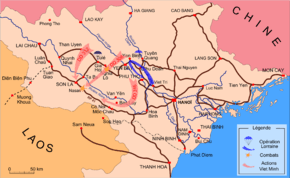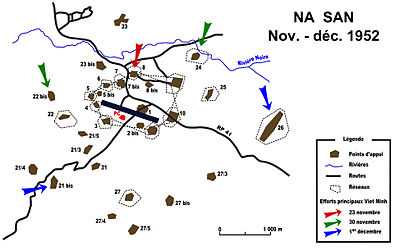Battle of Nà Sản
| Battle of Nà Sản | |||||||
|---|---|---|---|---|---|---|---|
| Part of First Indochina War | |||||||
 | |||||||
| |||||||
| Belligerents | |||||||
|
| ||||||
| Commanders and leaders | |||||||
| Jean Gilles | Võ Nguyên Giáp | ||||||
| Strength | |||||||
| 15,000, 6 artillery batteries | 3 divisions | ||||||
| Casualties and losses | |||||||
| Close to 2 battalions (around 500 men) | around 3000 dead and wounded | ||||||
The Battle of Nà Sản was fought between French Union forces and the Nationalist forces of the Việt Minh at Nà Sản, Sơn La Province, during the First Indochina War for control of the T’ai region (Northwest territory).
- "... Souhaitons que Giap commette l'erreur d'y venir!" ("Let's wish that Giap makes the mistake by coming!"). Bảo Đại
- "... sans elle (l'aviation), Na San n’était pas possible et je perdais la bataille du Nord-Ouest -" ( ... without it [air-support], Na San would not be possible and I would’ve lost the Northwest battle). Raoul Salan
- "... it (the battle) wasn’t a defeat—but we suffered losses." Võ Nguyên Giáp
- "Nous ne sommes pas entamés! Ca tient partout! C’est un déluge de feu indescriptible." ("We have not been breached! All (positions) hold! It is an indescribable deluge of fire.") Jean Gilles
Background
Military situation
Battle of Hòa Bình
In the Fall of 1950, General Marcel Carpentier decided to withdraw all military forces from Hòa Bình, capital of the Muong region. In November 1951, General De Lattre, Carpentier's replacement, launched an offensive operation against the Việt Minh in Hòa Bình to reclaim an area he saw as vital for France's future in Indochina. According to De Lattre, capturing Hòa Bình would cut the enemy's supply line between Thanh Hóa and Việt Bắc. Psychologically, reclaiming the province would gain support from the Mường, who had supported neither side, but were leaning more toward the Franco-Vietnamese side. In November 1951, De Lattre mobilized 10 infantry and eight airborne battalions in this decisive operation. Giáp counterattacked with three regular divisions, two independent regiments, and regional support troops. The two sides fought hard for Hòa Bình. At the height of the operations, Giáp had 40 battalions fighting his enemies at different locations throughout the province. In January 1952, French forces were winning when De Lattre had to go back to France for cancer treatment and General Salan was appointed to take his place. General Salan, who saw the province as an area that was hard to support and to defend, decided to withdraw his troops (Operation Amarante). On 22 February, French troops successfully withdrew from Hòa Bình and regrouped in Xuan Mai two days later.
T'ai region
Eight months after having successfully defended Hòa Binh, General Giáp attacked Nghĩa Lộ in the T'ai region which he failed to take a year earlier. General Giáp used four regular divisions (308th, 312th, 316th and artillery division 351st) to attack the province's southeast and the regional regiment 148th to guard the northwest side against reinforcements. In 10 days, Việt Minh forces not only took Nghĩa Lộ but also seized part of Sơn La and Lai Châu from French control. To avoid further losses, General Salan launched Operation Lorraine to relieve the Việt Minh pressure in the T'ai region and to serve as a diversion while Na San was being built. The operation, led by General de Linares, started on 9 November and lasted until 19 November. While the operation was going on, General Salan tasked Colonel Jean Gilles of establishing an entrenched fire support base at Nà Sản to stop Giáp's offensive.
Terrain
Nà Sản, located on Route Provinciale 41 (RP 41), was a valley of 2 km x 1 km surrounded by 24 hills that could serve as natural defense positions. In early October 1952, there was a single outpost and a short airstrip, both guarded by a company under the command of a non-commissioned officer. General Salan used the Hanoi-based French Air Force Dakotas to transport troops and material there in order to complete a fortified "base aero-terreste" or air-land base allowing a direct confrontation with the Việt Minh divisions.[1]:327
Prelude
Planning
During the battle, Colonel Gilles used a new tactic, called "the hedgehog" (le hérisson), for the first time in Indochina. The hedgehog defense consisted of an outpost surrounded by several armed positions (point d'appui or P.A.). The objective was to provoke an enemy frontal assault, rather than fighting off hit-and-run attacks or falling into ambushes. Nà Sản's hedgehog consisted of 30 P.A. with a complicated trench system, enforced with barbed wires. Its defense forces consisted of 11 battalions (15,000 men) and 6 artillery batteries.
Opposing forces
Franco-Vietnamese forces at Nà Sản
- Colonel Jean Gilles, Na San Commander
- Groupement Lansade
- 2nd battalion, 1st Algerian Light Infantry Regiment (II/1er Régiment de tirailleurs algériens)
- 3rd battalion, 3rd Foreign Infantry Regiment (III/3e régiment étranger d'infanterie), commandant Favreau
- 2nd battalion, 6th Moroccan Light Infantry Regiment (II/6e Régiment de tirailleurs marocains)
- Groupement mobile Vietnamien (Vietnamese Mobile Group)
- 1st Thai Battalion (BM/BT 1)
- 2nd Thai Battalion (BT 2)
- 3rd Thai Battalion (BT 3), commandant Vaudrey
- 55th BVN (55e Bataillon Vietnamien), capitaine Phạm Văn Đồng
- 3rd Battalion, 5th Foreign Infantry Regiment (III/5e régiment étranger d'infanterie), chef de bataillon Dufour
- Groupement parachutiste (Airborne Group)
Lieutenant colonel Ducourneau
- 1st Foreign Airborne Battalion (1er bataillon étranger de parachutistes or 1e BEP), chef de bataillon Brothier
- 2nd Foreign Airborne Battalion (2e bataillon étranger de parachutistes or 2e BEP), chef de bataillon Bloch
- 3rd Colonial Airborne Battalion (3e bataillon de parachutistes coloniaux or 3e BPC), capitaine Bonnigal
- Artillerie (Artillery)
- 5th Vietnamese Artillery Group (5e GAVN with 2 batteries of 105 howitzers)
- 41st Colonial Artillery Regiment (41e régiment d'artillerie coloniale)
- Foreign Legion Mortar Company (CMLE had one section with four 120 mm guns and one section with six 81 mm mortars)
- Génie (Engineer)
Commandant Casso
- 6 sections (2 companies)
Air support
- Aéronaval
- 8th flotilla (Privateer)
- 9th flotilla (SB2C Helldiver)
- 12th flotilla (Hellcat)
- Armée de l'air (Air Force)
- Gascogne 1/19 Bombing Group (B-26)
Việt Minh attacking forces
General Vo Nguyen Giap, Commander of the Tai region Campaign
- Dai doan 308 (Division 308)
Commander : Colonel Vuong Thua Tu
- Regiment 36
- Regiment 88
- Regiment 102
- Dai doan 312 (Division 312)
Commander : Colonel Le Trong Tan
- Regiment 141
- Regiment 165
- Regiment 209
- Dai doan 316 (Division 316)
Commander : Colonel Le Quang Ba
- Regiment 98
- Regiment 174
- Regiment 176
Battle

On 23 November at 20:00 Vietminh forces from the 88/308 twice attacked twice at P.A. 8 and were twice pushed back by the entrenched Franco-Vietnamese troops.[2]
From 24 to 30 November Vietminh forces made night attacks on different points to test French defense. During the days, defending troops patrolled within their fire-support range for reconnaissance.
At 8:00 PM on 30 November, Vietminh forces from 9 battalions attacked P.A. 22 bis and 24, respectively located east and west of the entrenched headquarters. P.A. 22 bis, defended by a company of the 2nd Thai battalion (BT2) was overrun by the 115th battalion (165/312) after 9 hours of relentless attacks, of the 225 men defending the P.A., only one squad was able to escape back to the airfield. P.A. 24 resisted 3 hours of constant attacks by the 102/308 before surrendering.
Colonel Gilles, who wanted to take back the 2 points so close to Na San's headquarters, launched a counter-attack at dawn on 1 December. After a barrage of artillery fire, two companies of the 2e BEP stormed and took back 22 bis. After 7 hard-fought hours, the 3e BPC took back P.A. 24. At 9:00 PM, General Giap's forces launched their all out offensive at Nà Sản. Wave after wave of soldiers relentlessly assaulted several P.A.s, especially 21 bis and 26; sometimes the attackers outnumbered the defenders fifteen to one. All night, Dakotas dropped flares over the battlefields to give support troops visibility to defend the positions. Defending forces continuously fired their cannons into Vietminh human waves while B-26s, Hellcats and Privateers dropped bombs and napalm onto enemy attack waves and positions. The battles raged on until mid-morning on 2 December when all attacks abruptly stopped, leaving behind an eerie silence.[2]
Aftermath
On 4 December after nearly 2 weeks of trying to overrun Na San, General Giap withdrew his troops leaving behind 1,544 dead and 1,932 wounded prisoners.[3] The defending Franco-Vietnamese forces lost close to 2 battalions.
Despite the victory, France was looking for a political solution to get out of Indochina and Na San was abandoned in August 1953. The tactician Colonel Gilles again outmaneuvered General Giap by evacuating the whole camp without a single loss. In "Ba sinh hương lửa", Doan Quoc Sy quoted a Vietminh officer with the forces surrounding Na San, "The enemy withdrew without our knowledge ... until there was only one battalion left ... the enemy was able to escape and save its entire forces because of our poor military intelligence".
The hedgehog tactics earned the French a victory at Nà Sản. As a result, the hedgehog defense became standard practice, and was applied on a larger scale at Điện Biên Phủ.
See also
References
Bibliography
- Lt. Gen. Phillip B. Davidson, USA (Ret.) (1998). Vietnam at War. Presidio Press. ISBN 0-89141-306-5.
- Dufour, Nicolas (October 1999). NASAN, La victoire oubliée (1952–1953) [Nasan, the forgotten victory (1952–1953)] (in French). Economica. ISBN 2-7178-3940-2.
- Salan, Raoul Albin Louis (1971). Memoires: fin d'un empire, tome 2: Le Viet Minh mon adversaire [Memoires: the end of an empire, volume 2: Viet Minh, my adversary] (in French). Paris: Presses de la Cite.
- Simpson, Howard R. (August 1992). Tiger in the Barbed Wire: An American in Vietnam, 1952–1991. Brassey's Inc. ISBN 0-7881-5148-7.
- AFRVN Military History Section, J-5, Strategic Planning and Policy. Quân Sử 4: Quân lực Việt Nam Cộng Hòa trong giai-đoạn hình-thành: 1946–1955 (reprinted from the 1972 edition in Taiwan, DaiNam Publishing, 1977) [AFRVN, the formation period, 1946–1955] (in Vietnamese).
- Doan Quoc Sy (1962). Ba sinh hương lửa [Three periods of Fire] (in Vietnamese). Saigon: Sáng Tạo.
- Dinh Xuan Lam (1998). Lich Su 12, Tap 2 [12th Grade History, Volume 2] (in Vietnamese). HCM City, Vietnam: Ministry of Education.
External links
- Views upon Indo-China #4: Na San, a battle in the jungle, French Army Cinematographic Service (SCA#64), 7 May 1953
- (French) The battle of Na San, October–December 1952, R. Vercken & P. Gras (airforce in the battle)
- "Dossier Indochine" [Indochina Document] (in French).
- "Showdown at Nghia Lo".
- "Le général Jean Gilles" [Biography of Jean Gilles] (in French).
- "La bataille de Na San, Octobre-Décembre 1952, R. Vercken & P. Gras" (in French).
- "Combat de Na San" [Na San Combat]. Friends of the Paris French Foreign Legion (in French).
- "Trận tiến công cứ điểm Gò Hồi – Nà Sản" [the attack on Go Hoi – Na San (P.A. 22 bis)] (in Vietnamese).
- "Military Improvisations during the Russian Campaigns (Chapter 2-1: Improvised Hedgehog Defenses)". Washington, D.C.: US Army Center of Military History. 1986.